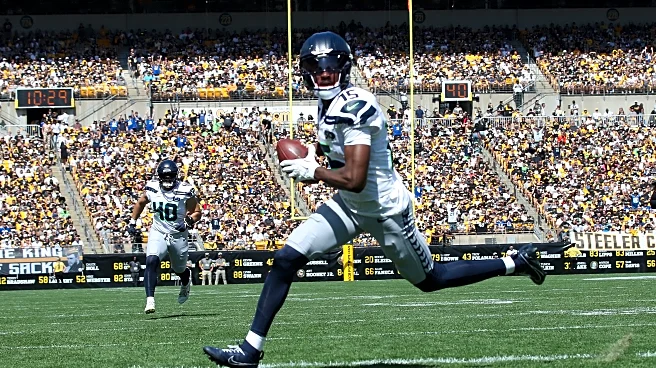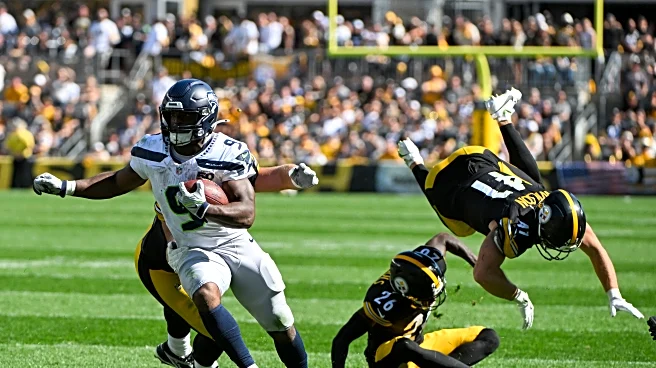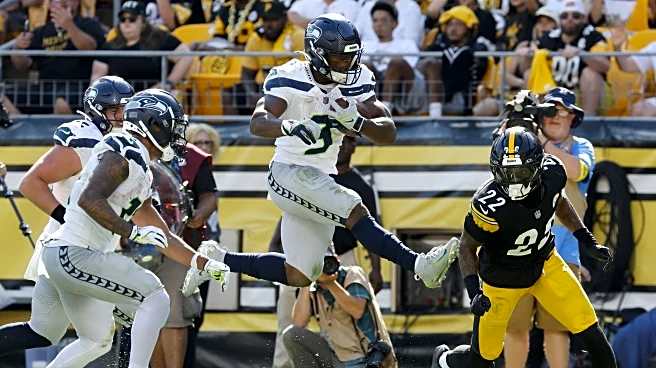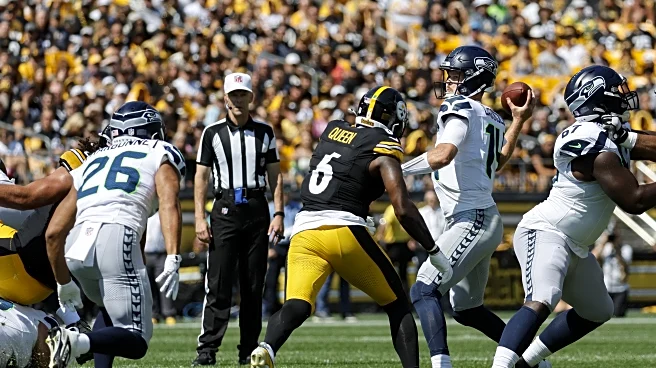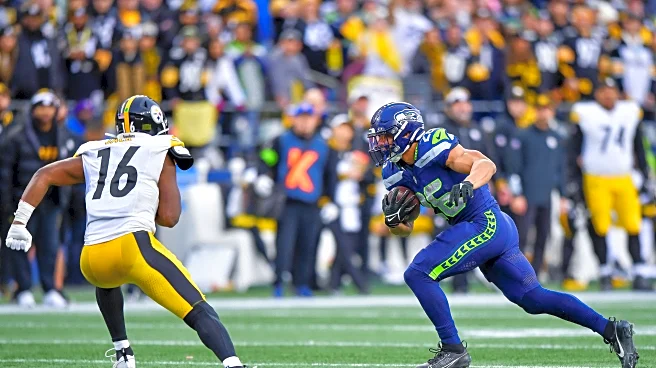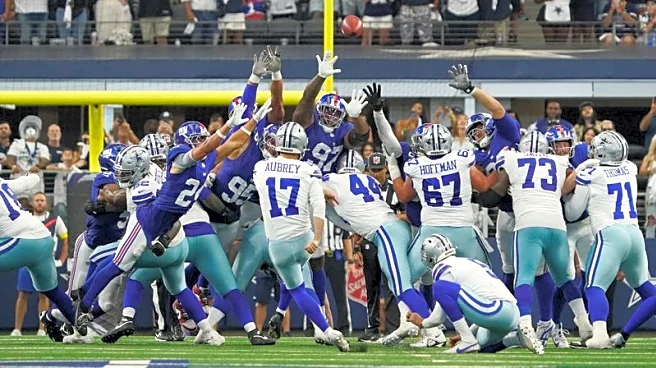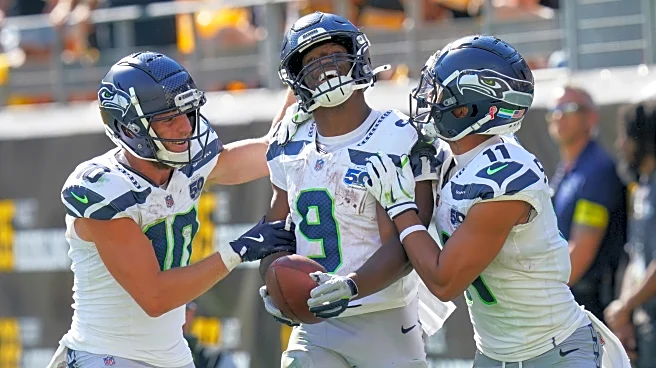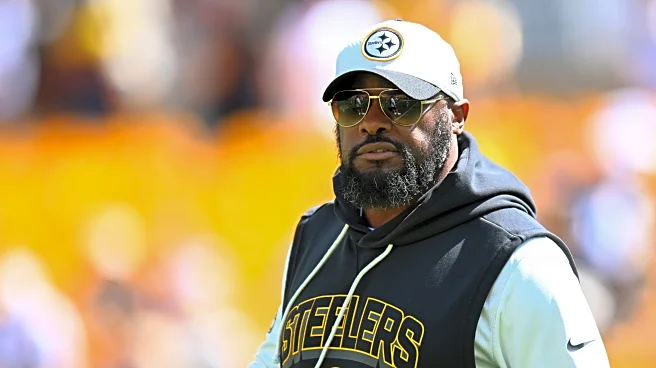The Seattle Seahawks got their first win of the season. The start was rough, and it looked like the Seahawks would let the win slip away after shooting themselves in the foot several times in the first half. A win is important in an away game against a team that’s tough to beat at home.
Let’s look at the All-22 and see what happened in last week’s 31-17 win. All data used in this article was taken from PFF.
The Bad
The inconsistency of the offensive line
The Seahawks rushed for 117 yards, averaging
four yards per carry. They helped Ken Walker (who entered the Seahawks’ top 10 in rushing yards, surpassing Maurice Morris) achieve his first 100-yard game since his 2024 opener against the Broncos.
In pass protection, they had 15 pressures, 2 sacks allowed, 6 hits, and 2 players with a pass-block rating of 30 or less. The highest rating (Charles Cross) was only 68.7.
The unit had some good plays over the two weeks, but the main problem, in my view, has been consistency (or rather, the lack thereof). The offensive line is capable of opening up wide spaces for the run, creating clean pockets while delivering quick pressure and tackling behind the line of scrimmage.
They had 9 carries for 0 or fewer yards. If you increase the criteria to 3 yards or less, the number increases to no less than 18. You can’t look at the Seahawks’ OL and firmly believe the team will be able to convert a short third or fourth down. It’s as if anything is possible.
The offensive line can’t create movement in the encounter with the DL and leaves the RB essentially with no way out. Abe Lucas can’t block TJ Watt, and the tackle is made.
Besides these “physicality” issues, there were problems with the execution of the runs. On this play, Bradford goes to the second level but leaves Patrick Queen unblocked, and the LB has a clear path to the RB.
This type of confusion also occurred in pass protection. The right OL has four players to block three. Abe Lucas seems to be waiting for a chip block and then blocking TJ Watt. He gets lost and doesn’t block anyone (basically, three players are around Watt), and Jack Sawyer has a clear path to the QB.
The Steelers used this type of stunt a lot throughout the game and were mostly successful, taking advantage of the Seahawks’ OL having no response. Watt comes from the D-gap on the right side, basically to the A-gap on the left.
Pause to highlight this incredible crack block by Cooper Kupp. The receiver had an 89 run-blocking grade and leads WRs in zone blocking grade in the first two weeks with an 85.4.
Returning to the inconsistencies, let’s look at Bradford as an example.
On this snap, he manages to show all his strength (even though he wasn’t able to hold the block long enough).
Here, he fails to reach the second level, and this failure results in the failure of the run.
And I won’t even get into the merits of the pass block. The pressure arrives in essentially less than two seconds.
There’s still room for improvement on defense
The Seahawks continue to pressure the opposing quarterback, and despite improving their sack count (three in this game), I believe they still need adjustments. The consistency of pressure from the wedges needs to improve (Uchenna Nwosu still looks rusty after so long out).
Aaron Rodgers is one of the most intelligent quarterbacks in the league, but he’s 41 years old. Still, he’s managed to find ways to extend plays or “nullify” pressure with quick passes. Jaylen Warren caught four passes for 86 yards, but it’s worth noting that only one of them totaled 65 yards.
And speaking of that play, it was a defensive error. It started with Tyrice Knight, who was responsible for the cornerback on most of the plays. The cornerback looks at the quarterback and loses the cornerback’s tracking, giving him a chance to complete the pass. After that, he and Ernest Jones miss tackles (something unusual), other players follow suit in a somewhat passive stance, and the Steelers end up in the red zone. Riq Woolen made the touchdown saving tackle.
Another play where the team missed the opportunity to make a play. Yes, ARod is one of the best at this fake handoff, but almost half the Seahawks defense bought the run, leaving the QB free to complete the pass.
Riq Woolen’s situation is still worrying
Woolen gave up two receptions on two targets for 18 yards. His highlight of the game was the tackle on the play we discussed in the thread above. However, he committed an unnecessary foul that saved a third down for the Steelers.
Furthermore, just like in Week 1, he displayed the same problem attacking the ball at his highest point. This play was against DK Metcalf, so it wouldn’t have been easy, but Woolen offered no resistance.
Woolen is the prototypically perfect CB. It’s as if he was created in Madden. He lacks consistent intensity and aggressiveness.
Sam Darnold being Sam Darnold
If you weren’t familiar with Sam Darnold’s play, the game against the Steelers showcased his entire portfolio, both positive and negative. Kubiak’s scheme doesn’t require a rare talent, but rather someone capable of executing simple calls. Consider what Mac Jones did for the 49ers against the Saints, using a similar scheme.
Sam Darnold’s interceptions were concerning. They were errors in execution/technique and decision-making. As a result, the QB finished the day 22-of-33, with 295 yards, 2 TDs, and 2 INTs.
There are different factors that can lead to an interception. It could be context, an offensive line error, a receiver running a poor route, the defender’s merit, or even a poor call. None of these factors led to Darnold’s first interception. The pocket was clean, and the call was good enough to leave open space toward the sideline. However, the error was purely a matter of execution by the QB. The pass should have been much more directed to the sideline, where the receiver would have an advantage. Yes, Jalen Ramsey made a great play, but here the main blame lies with Darnold.
The second interception is also Darnold’s fault, but the main reason is his decision-making after a mistake in pass protection. There’s a saying in Brazil that sometimes you have to take a step back to take two forward. The Seahawks are on fourth-and-1 and decide not to run the ball (due to the OL’s inconsistency) and don’t go for the TE sneak with AJ Barner.
The call gave Sam Darnold the option to AJ Barner on a short flat route, and the conversion would likely have been successful. The problem is that the rookie fullback misses the cut block and allows a rusher to get right up to the QB. In this context, Darnold makes a poor decision: forcing the pass. You might think that on fourth down there would be no harm in fumbling the ball, but it turns into an interception returned to the red zone (and could have been a pick six) and that field position resulted in the Steelers’ only TD drive.
Still, Darnold made some good plays in the game, including on third-downs, demonstrating composure and waiting until the last moment to throw the ball. On this play, he already has Jaxon Smith-Njigba as his primary target and realizes that the Steelers’ man-to-man call would give him a chance. Even with a defender charging at him, he waits until the right moment to make the pass, makes the conversion, and takes the hit.
This was a play that happened at a crucial moment and was perhaps one of Darnold’s best. As mentioned in a previous thread, the Seahawks struggled with stunts. The Steelers called a stunt on this play, and a defender had a clear path to Darnold, who, despite not being a mobile QB, managed to escape the pocket and throw under pressure to Barner for the conversion.
The Good
Josh Jobe continues to fight for the starting job
According to PFF, Seahawks cornerback Josh Jobe allowed one reception for seven yards on four targets as the closest defender, with one pass defensed. In two games: nine targets, two receptions for eight yards, one INT, and one PD. In Week 1, his NFL Passer Rating allowed was ZERO. Of course, two games is still not enough. But Jobe’s two starts in 2025 are better than any other game on his resume.
This snap is an example of what Jobe managed to do basically the entire game. A suffocating defense, leaving no space, whether in deep or double-moves.
Aaron Rodgers makes his progressions and waits for DK Metcalf in deep. However, Jobe has good step-by-step coverage with the receiver, and the QB has to hold the ball and ends up getting sacked.
This was basically Jobe’s only bad play of the game. It would have been a shame if he had given up the TD here. He stopped and gave up on the play and allowed the receiver to come back and try to make the catch. But this time, luck was on the Seahawks’ side; the ball went up and ended up being intercepted by Derion Kendrick.
Keep pressuring
The Seahawks lead the NFL with a 49.4% pressure rate via @NextGenStats, despite using a four-man front at 83% of the time and being the second-to-last team in blitzing the least (13%), behind only the Bengals.
Boye Mafe has been playing very well and hasn’t been talked about much. He’s greatly improved his technique for inside moves, and this has been a problem for the linebackers.
In the snap above, he takes advantage of the RT’s big step outside and uses a swipe move to attack inside and force an incomplete pass.
Mafe adopts a speed-to-power stance, and the OT prepares for it, making himself susceptible to the edge’s inside move, which again puts pressure on the QB and forces him out of the pocket.
Eventually, these pressures will turn into sacks…
Another player worth mentioning is Byron Murphy II. He’s been a pillar in the running game and has also managed to achieve good pass rush numbers. Murphy uses a stutter step to get the center’s attention while Jarran Reed executes the stunt move. Uchenna Nwosu also attacks the inside gap, and Murphy loops the ball, “jumping” two gaps, quickly reaching Rodgers, who throws the ball away.
Klint Kubiak’s true debut
I don’t think Kubiak is the NFL’s next great offensive genius, but he’s clearly capable of doing more than he did in Week 1. Adjustments have been made:
- Against the 49ers, the Seahawks were shotgun on 62% of their snaps, a figure that dropped to 40% against the Steelers;
- The Seahawks called only two play-action plays in Week 1 compared to 10 in Week 2.
This play epitomizes Kubiak’s offense. The Seahawks move the fullback to the right side, fake a toss to the same side, while Elijah Arroyo comes in the opposite direction. This misdirection moves the second level of the defense, leaving room for Arroyo’s speed to emerge. There’s no complex read here; the quarterback makes life easier for the quarterback; it’s just a matter of passing the ball.
More misdirection. Gray Zabel is sent in for a pull, and another fake toss occurs. Arroyo is also put in motion to threaten a block, but the idea is actually to give him a free release. Once again, the second level of the defense takes the bait and leaves space behind him.
The play design is incredible, but JSN still finds a way to excel. The receiver realizes that Jalen Ramsey has entered pursuit mode on Arroyo and left a clear zone. He adjusts his route and points to Darnold where the pass should be thrown.
One of Kubiak’s trademarks finally appears. By my count, there were at least three Yankee concept calls in the game, including the first TD.
Yankee is a play with a longer development. It’s usually executed from a play-action with eight or nine men. Run-heavy formations force the defense to bring players into the box and ensure a single safety look deep downfield.
The Yankee concept consists of two main routes. Sometimes there are checkdown routes with running backs or TEs escaping into the flats. These main routes are:
- A 16-18 yard dig route;
- A post route on the opposite side;
The read is simple: the safety attacked the dig (as in the TD play), the pass goes to the post, and vice versa.
Final Thoughts
Starting 0-2 would have put enormous pressure on the Seahawks and wouldn’t have done justice to what the team has shown (even though there’s plenty of room for improvement). Starting 0-2 would have also put additional pressure on the Seahawks facing the Saints, who’ve already lost to two of Seattle’s NFC West rivals (and looking toward the end of the season, winning is crucial as well).
As mentioned throughout the article, there’s room for the team to improve, especially on offense. However, it’s much better to make these adjustments while winning games than the other way around.

